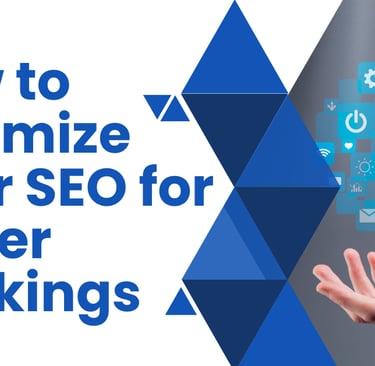How to Optimize Your SEO for Better Rankings
Learn how to optimize your SEO for better Google rankings. Discover expert digital marketing tips to boost traffic, visibility, and online growth.
DIGITAL MARKETINGSEO
Asad Ali
10/25/20254 min read


Introduction
In today’s digital world, having a website isn’t enough — it must be visible. Whether you run an e-commerce brand, a service-based business, or a blog, SEO (Search Engine Optimization) plays a vital role in determining your online success.
SEO is one of the most powerful parts of Digital Marketing — it helps you reach your target audience, improve search visibility, and drive organic traffic without paid ads. This article will explain how to optimize your SEO for better rankings, using simple strategies and real examples so you can apply them even if you’re just starting.
1. Understand What SEO Really Means
Many people think SEO is just about adding keywords, but it’s much more than that.
SEO is the process of improving your website so that search engines like Google can understand, index, and recommend it to users. It involves:
Technical optimization (site speed, mobile friendliness, indexing)
On-page optimization (keywords, content quality, headings)
Off-page optimization (backlinks, social signals, credibility)
Think of SEO as the foundation of your digital marketing strategy. Without it, your content won’t reach the right audience — no matter how great it is.
2. Start with Keyword Research
Before you write or publish anything, you must know what people are searching for.
Use tools like Google Keyword Planner, Ahrefs, or Ubersuggest to find high-volume and low-competition keywords. For example, if you’re a digital marketing strategist, you can target keywords like:
digital marketing for startups
white label digital marketing
aceless digital marketing
digital marketing for plumbers
digital marketing for manufacturers
These terms are specific and can help you rank faster in your niche. Once you have your keywords, use them naturally in your titles, headings, and throughout your content.
3. Create Quality Content — Not Just Quantity
Search engines reward useful, informative, and well-written content. Publishing ten low-quality posts won’t help as much as one detailed, valuable article that answers real questions.
Uses keywords naturally
Answers user intent clearly
Provides depth with facts, data, and insights
Keeps readers engaged with examples or visuals
For instance, if you’re writing about “Digital Marketing for Manufacturers,” explain real-world challenges they face — like finding B2B clients — and how online marketing helps solve them. That’s how you build relevance and authority.
4. Optimize On-Page SEO
Once your content is ready, focus on on-page SEO elements — small but powerful changes that boost your search visibility.
Key Areas to Optimize:
Title Tag: Keep it under 60 characters, include your main keyword.
Example: “Best Digital Marketing Strategies for 2025”
Meta Description: 150–160 characters summarizing your article with action words.
Headings (H1, H2, H3): Use headings to organize your content and naturally include related terms.
Internal Links: Link to other relevant pages or blogs on your site — it improves navigation and SEO ranking.
Images: Add ALT text that describes your image content for both SEO and accessibility.
These improvements help search engines understand your topic better and make your site more user-friendly.
5. Improve Site Speed and Mobile Experience
Google prioritizes websites that load quickly and work smoothly on mobile devices. If your site takes too long to open, visitors leave — and search engines notice.
Easy Fixes:
Compress large images before uploading
Use caching plugins or CDNs (Content Delivery Networks)
Avoid heavy pop-ups or auto-play videos
Test your website with Google PageSpeed Insights
A faster website not only ranks better but also provides a better user experience — one of the core factors Google measures in its ranking algorithm.
6. Build Authority with Backlinks
Backlinks (links from other websites to yours) are like votes of trust. The more quality backlinks you have, the higher your credibility in Google’s eyes.
How to Build Backlinks:
Write guest blogs for trusted industry sites.
Collaborate with influencers or small businesses.
Submit your website to niche directories (e.g., for startups, agencies, or manufacturers).
Share your posts on LinkedIn, Medium, and social media.
A single backlink from a high-authority site is worth more than dozens of low-quality ones. Remember, SEO is about quality over quantity.
7. Monitor Analytics and Adjust
SEO is not a one-time process — it’s an ongoing improvement strategy.
Use tools like Google Analytics and Google Search Console to track performance. Check:
Which pages get the most traffic
What keywords bring visitors
How long users stay on your page
Where they drop off
If you see some pages ranking low, update them with better keywords or improved visuals. Regular updates show search engines that your site is active and reliable.
8. Stay Updated with Digital Marketing Trends
SEO evolves quickly. What worked last year may not work today.
For example, Google’s latest updates focus more on user experience, helpful content, and mobile-first indexing.
Following digital marketing news (April 2025) helps you stay ahead. Read updates from platforms like Search Engine Journal, Moz, or Google Search Central to learn about new ranking factors, AI integration, and algorithm changes.
As a digital marketing strategist, staying informed ensures your SEO strategies are always aligned with what search engines value most.
9. Optimize for Local and Voice Search
Local SEO is crucial if your business serves specific areas — like digital marketing for plumbers or agencies for startups.
Include location-based keywords such as:
“Digital marketing agency in Dubai”
“SEO company for small businesses in UAE”
Also, voice searches are rising rapidly. People use conversational phrases like “best digital marketing services near me.” Use natural language in your content to capture these searches.
10. Measure, Learn, and Evolve
The best digital marketers don’t guess — they analyze.
Once your SEO strategy is running, measure your results monthly. Identify what’s working and what needs improvement.
If your traffic is rising but conversions aren’t, focus on call-to-actions (CTAs) and user experience. If you’re getting clicks but low rankings, optimize for keyword intent and link building.
The key to long-term success is adaptability — SEO rewards those who learn and evolve consistently.
Conclusion
Optimizing your SEO for better rankings takes time, effort, and strategy — but the results are worth it.
By combining strong keyword research, technical improvements, and quality content, you can build an online presence that stands out in today’s crowded digital space.
Whether you’re a digital marketing strategist, a business owner, or part of a digital marketing agency for startups, mastering SEO will always be your most valuable investment in digital growth.
Remember — in the world of Digital Marketing, visibility means opportunity. Start optimizing today, and watch your business climb the search results tomorrow.
